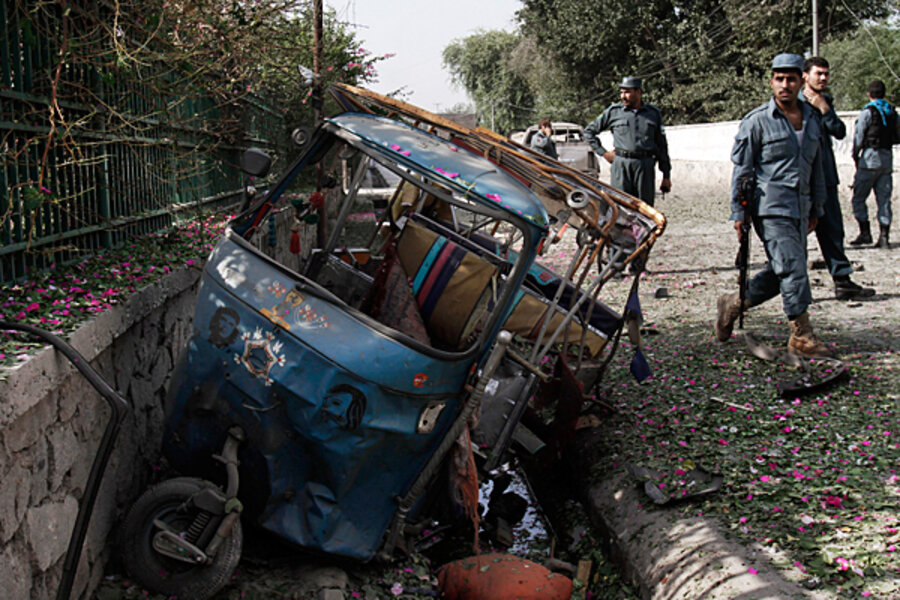Is the Taliban wearing out its welcome in Afghanistan?
Loading...
| Kandahar and Ghazni, Afghanistan
After US Army Staff Sgt. Robert Bales allegedly walked off a US base in Kandahar last March and went house to house, killing a total of 17 Afghan civilians, many worried that the Taliban would capitalize on the incident and the long restive province would revert to violence.
Yet more than five months later, violence in Kandahar remains at record lows. Compared with the same time last year, the Kandahar governor’s office reports that insurgent attacks and activity are down 75 percent.
Marking a new development, not only did the Taliban fail to use the shooting spree as a propaganda tool to renew their momentum, but a growing number of residents say they’ve grown frustrated with the group and increasingly intolerant of its activities.
“The bad behavior of the Taliban with the local people – when they use their fields, houses, mosques, and streets as their battlefield, when they put landmines in roads and in their fields – has shifted the sympathy of the people toward the government. People are very unhappy with the Taliban about these issues,” says Haji Fazel Mohammad, the district governor of Panjwayi, where the Bales incident occurred.
Throughout Afghanistan, many locals are losing whatever sympathy they may have once had for the Taliban. In Ghazni Province in eastern Afghanistan, a group of locals in Andar district rose up against the extremist group after it shut down a majority of schools in the area.
The uprising, which began in May, failed to spread beyond Andar and there are a number of indications that local politics and power struggles may have had just as much, if not more, to do with the uprising than frustration with the Taliban. Most evidence points to a conflict between Afghanistan’s Hezeb-e Islami, a more moderate Islamic group, and the Taliban that has reportedly been taking place in Wardak and Ghazni for some time now.
Still, as US and NATO forces work to hand over security responsibilities to their Afghan counterparts ahead of the 2014 deadline to end their combat operations, there is hope that evaporating support for the Taliban may lay the foundation for long-term stability in Afghanistan.
“Much like what happened in Iraq where there was a turning point after Al Qaeda in Iraq had killed so many of the people and done so many beheadings and intimidated so many, the people finally got tired of it and stood up and fought back. That was the turning point in Iraq. The same type of turning point can occur and will occur here,” says US Army Lt. Col. Praxitelis “Nick” Vamvakias, commander of the 2-504 Parachute Infantry Regiment in Ghazni Province.
Taliban have got the message
Unlike in Iraq, locals say the Taliban received the message after the uprising in Ghazni’s Andar district and backed off from some of its more aggressive behavior.
“The situation is becoming normal again after the uprising. There are no Taliban in the area where the uprising happened. In the other areas of Andar where there was no uprising, the Taliban’s behavior with the people has changed. They are a little softer,” says Shahbaz, a farmer in Andar district who, like many Afghans only has one name.
Additionally, throughout Afghanistan, as in Kandahar and especially Ghazni, the Taliban remain a considerable threat. Despite being an area of focus for the US military this past year, with NATO forces tripling there, many areas of the province remain restive and dangerous.
Within the Afghan government, the Parliament has been so frustrated with its military’s inability to reign in violence and stop assassinations that it forced the resignation of the country’s minister of defense and interior.
Afghans more pro government?
Even if the Taliban continues to lose the support of the population, it does not necessarily mean the local population is now siding with the Afghan government and international forces.
With the security situation and political future of Afghanistan still far from stable or certain – yesterday marked the deadliest day of 2012 for Afghan civilians – many analysts say that Afghans, especially those in rural areas appear to be hedging their bets.
That the US military and NATO will end their combat mission here in 2014 is no secret, making many Afghans weary of looking to international troops for enduring support. The Afghan government’s reputation for pervasive corruption has also made a number of locals hesitant to place their allegiances there.
“There are lots of people here in Kabul who want to brand it as a kind of uprising that has ceased the nation, but I think that’s too simplistic,” says Alex Strick van Linschoten, an independent researcher and author of “An Enemy We Created: The Myth of the Taliban/Al-Qaeda Merger in Afghanistan.”
Speaking about recent security improvements in Kandahar, he adds, “It seems that people are happy with the situation and they don’t want it to go back how it was before, yet at the same time that doesn’t mean they think the government is the greatest thing ever.”
Possible trend?
Amid this climate, many Afghan observers say that its unlikely widespread frustration will translate into a nationwide uprising, or even sweep through the rest of Ghazni Province.
Few Afghans possess the means to revolt. It is among the 10 poorest countries in the world and has a per capita GDP of $528. Facing this level of destitution, for Afghans living hand-to-mouth, abandoning their fields or jobs to fend off the Taliban is simply not an option.
“Our people are very poor. They are always worried about covering their daily expenses and surviving. As long as they are uncertain about whether their children can survive, how can they be ready for an uprising? Economically, if they are supported and they are more secure financially then I think in that case they will start to rise up against the Taliban,” says Mohammad Isa Khan, a former attorney general and independent analyst in Kandahar.








